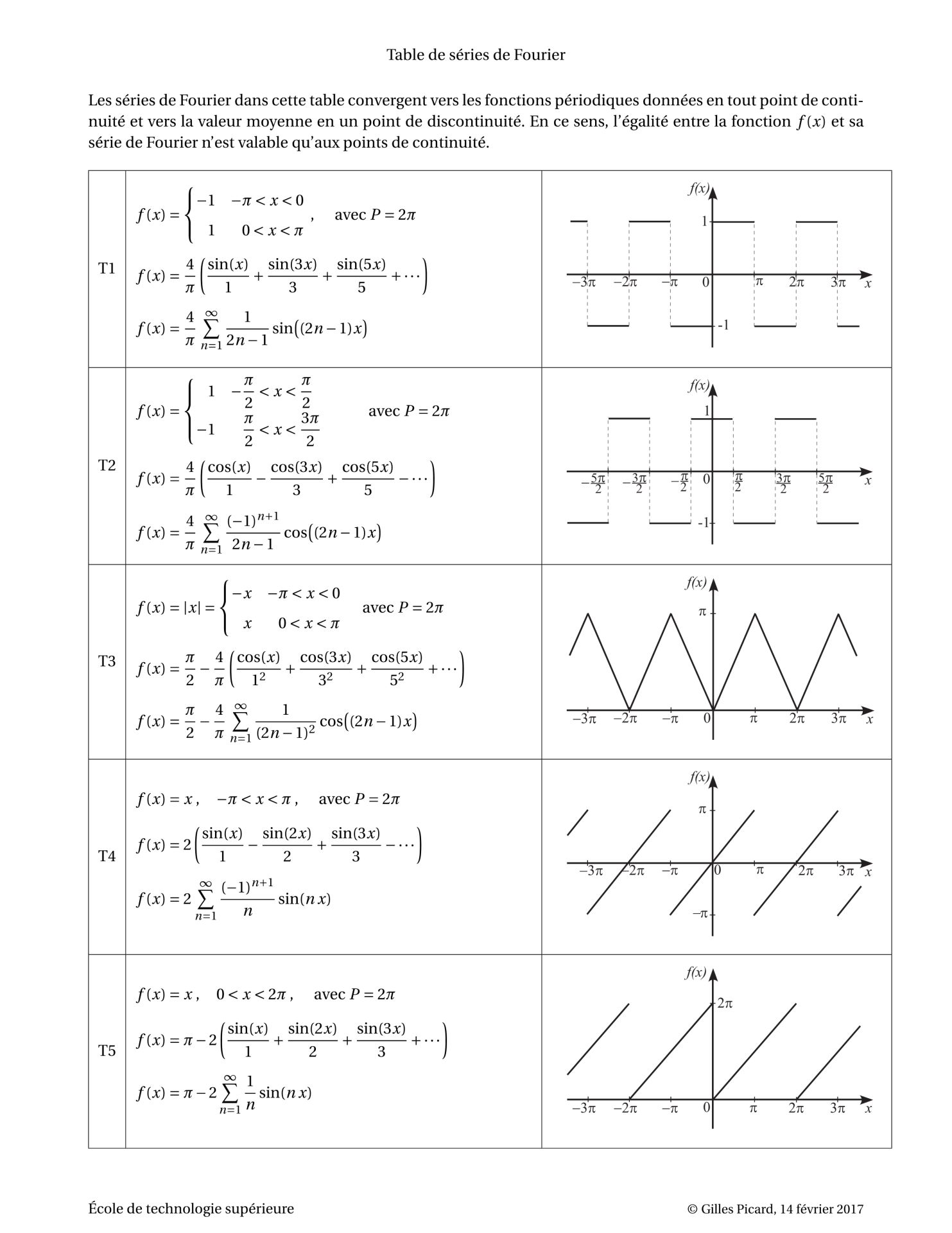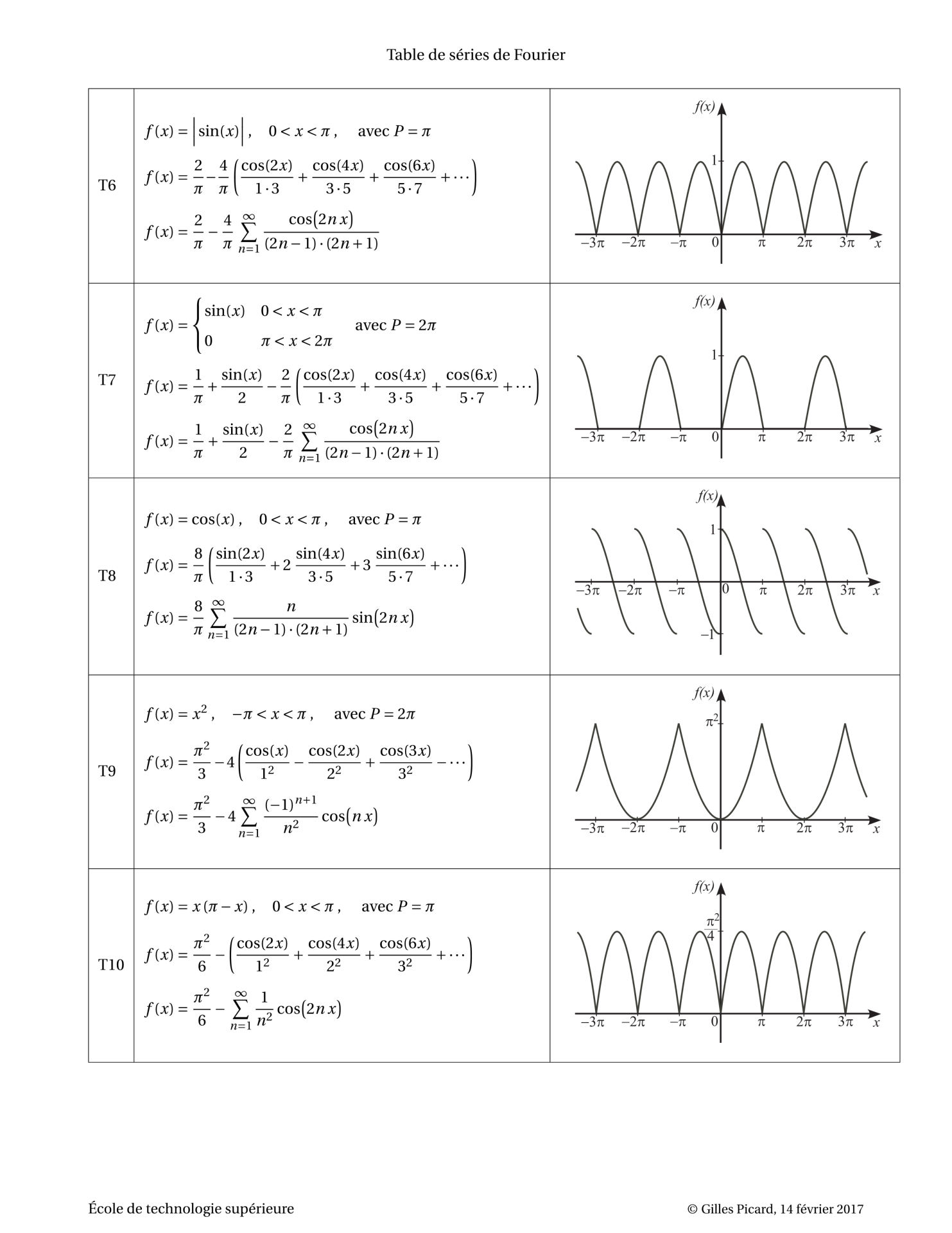푸리에 급수 테이블 , 푸리에 변환 테이블, Fourier Series Table, Fourier Transform Table
출처 : https://ena.etsmtl.ca/pluginfile.php/137982/mod_resource/content/8/Fourier-table.pdf


출처 : https://en.wikipedia.org/wiki/Fourier_transform
Functional relationships, one-dimensional
The Fourier transforms in this table may be found in [Erdélyi 1954] or [Kammler 2000, appendix].
| Function | Fourier transform unitary, ordinary frequency |
Fourier transform unitary, angular frequency |
Fourier transform non-unitary, angular frequency |
Remarks | |
|---|---|---|---|---|---|
| \[f(x)\] | \[\begin{align} &\widehat{f}(\xi) \triangleq \widehat {f_1}(\xi) \\&= \int_{-\infty}^\infty f(x) e^{-i 2\pi \xi x}\, dx \end{align}\] | \[\begin{align} &\widehat{f}(\omega) \triangleq \widehat {f_2}(\omega) \\&= \frac{1}{\sqrt{2 \pi}} \int_{-\infty}^\infty f(x) e^{-i \omega x}\, dx \end{align}\] | \[\begin{align} &\widehat{f}(\omega) \triangleq \widehat {f_3}(\omega) \\&= \int_{-\infty}^\infty f(x) e^{-i \omega x}\, dx \end{align}\] | Definitions | |
| 101 | \[a\, f(x) + b\, g(x)\] | \[a\, \widehat{f}(\xi) + b\, \widehat{g}(\xi)\] | \[a\, \widehat{f}(\omega) + b\, \widehat{g}(\omega)\] | \[a\, \widehat{f}(\omega) + b\, \widehat{g}(\omega)\] | Linearity |
| 102 | \[f(x - a)\] | \[e^{-i 2\pi \xi a} \widehat{f}(\xi)\] | \[e^{- i a \omega} \widehat{f}(\omega)\] | \[e^{- i a \omega} \widehat{f}(\omega)\] | Shift in time domain |
| 103 | \[f(x)e^{iax}\] | \[\widehat{f} \left(\xi - \frac{a}{2\pi}\right)\] | \[\widehat{f}(\omega - a)\] | \[\widehat{f}(\omega - a)\] | Shift in frequency domain, dual of 102 |
| 104 | \[f(a x)\] | \[\frac{1}{|a|} \widehat{f}\left( \frac{\xi}{a} \right)\] | \[\frac{1}{|a|} \widehat{f}\left( \frac{\omega}{a} \right)\] | \[\frac{1}{|a|} \widehat{f}\left( \frac{\omega}{a} \right)\] | Scaling in the time domain. If \[{{abs|a}}\] is large, then \[f(ax)\] is concentrated around 0 and \[\frac{1}{|a|}\hat{f} \left( \frac{\omega}{a} \right)\] spreads out and flattens. |
| 105 | \[\widehat {f_n}(x)\] | \[\widehat {f_1}(x) \ \stackrel{\mathcal{F}_1}{\longleftrightarrow}\ f(-\xi)\] | \[\widehat {f_2}(x) \ \stackrel{\mathcal{F}_2}{\longleftrightarrow}\ f(-\omega)\] | \[\widehat {f_3}(x) \ \stackrel{\mathcal{F}_3}{\longleftrightarrow}\ 2\pi f(-\omega)\] | The same transform is applied twice, but x replaces the frequency variable (ξ or ω) after the first transform. |
| 106 | \[\frac{d^n f(x)}{dx^n}\] | \[(i 2\pi \xi)^n \widehat{f}(\xi)\] | \[(i\omega)^n \widehat{f}(\omega)\] | \[(i\omega)^n \widehat{f}(\omega)\] | nth-order derivative. As \[f\] is a [[Schwartz space|Schwartz function]] |
| 106.5 | \[\int_{-\infty}^{x} f(\tau) d \tau\] | \[\frac{\widehat{f}(\xi)}{i 2 \pi \xi} + C \, \delta(\xi)\] | \[\frac{\widehat{f} (\omega)}{i\omega} + \sqrt{2 \pi} C \delta(\omega)\] | \[\frac{\widehat{f} (\omega)}{i\omega} + 2 \pi C \delta(\omega)\] | Integration.[1] Note: \[\delta\] is the [[Dirac delta function]] and \[C\] is the average ([[DC component|DC]]) value of \[f(x)\] such that \[\int_{-\infty}^\infty (f(x) - C) \, dx = 0\] |
| 107 | \[x^n f(x)\] | \[\left (\frac{i}{2\pi}\right)^n \frac{d^n \widehat{f}(\xi)}{d\xi^n}\] | \[i^n \frac{d^n \widehat{f}(\omega)}{d\omega^n}\] | \[i^n \frac{d^n \widehat{f}(\omega)}{d\omega^n}\] | This is the dual of 106 |
| 108 | \[(f * g)(x)\] | \[\widehat{f}(\xi) \widehat{g}(\xi)\] | \[\sqrt{2\pi}\ \widehat{f}(\omega) \widehat{g}(\omega)\] | \[\widehat{f}(\omega) \widehat{g}(\omega)\] | The notation \[f * g\] denotes the [[convolution]] of \[f\] and \[g\] — this rule is the [[convolution theorem]] |
| 109 | \[f(x) g(x)\] | \[\left(\widehat{f} * \widehat{g}\right)(\xi)\] | \[ \frac{1}{\sqrt{2\pi}} \left(\widehat{f} * \widehat{g}\right)(\omega) \] | \[\frac{1}{2\pi}\left(\widehat{f} * \widehat{g}\right)(\omega)\] | This is the dual of 108 |
| 110 | For \[f(x)\] purely real | \[\widehat{f}(-\xi) = \overline{\widehat{f}(\xi)}\] | \[\widehat{f}(-\omega) = \overline{\widehat{f}(\omega)}\] | \[\widehat{f}(-\omega) = \overline{\widehat{f}(\omega)}\] | Hermitian symmetry. \[\overline{z}\] indicates the [[complex conjugate]]. |
| 113 | For \[f(x)\] purely imaginary | \[\widehat{f}(-\xi) = -\overline{\widehat{f}(\xi)}\] | \[\widehat{f}(-\omega) = -\overline{\widehat{f}(\omega)}\] | \[\widehat{f}(-\omega) = -\overline{\widehat{f}(\omega)}\] | \[\overline{z}\] indicates the [[complex conjugate]]. |
| 114 | \[\overline{f(x)}\] | \[\overline{\widehat{f}(-\xi)}\] | \[\overline{\widehat{f}(-\omega)}\] | \[\overline{\widehat{f}(-\omega)}\] | [[Complex conjugation]], generalization of 110 and 113 |
| 115 | \[f(x) \cos (a x)\] | \[\frac{\widehat{f}\left(\xi - \frac{a}{2\pi}\right)+\widehat{f}\left(\xi+\frac{a}{2\pi}\right)}{2}\] | \[\frac{\widehat{f}(\omega-a)+\widehat{f}(\omega+a)}{2}\] | \[\frac{\widehat{f}(\omega-a)+\widehat{f}(\omega+a)}{2}\] | This follows from rules 101 and 103 using [[Euler's formula]]: \[\cos(a x) = \frac{e^{i a x} + e^{-i a x}}{2}.\] |
| 116 | \[f(x)\sin( ax)\] | \[\frac{\widehat{f}\left(\xi-\frac{a}{2\pi}\right)-\widehat{f}\left(\xi+\frac{a}{2\pi}\right)}{2i}\] | \[\frac{\widehat{f}(\omega-a)-\widehat{f}(\omega+a)}{2i}\] | \[\frac{\widehat{f}(\omega-a)-\widehat{f}(\omega+a)}{2i}\] | This follows from 101 and 103 using [[Euler's formula]]: \[\sin(a x) = \frac{e^{i a x} - e^{-i a x}}{2i}.\] |
[1] The Integration Property of the Fourier Transform
| Function | Fourier transform unitary, ordinary frequency |
Fourier transform unitary, angular frequency |
Fourier transform non-unitary, angular frequency |
Remarks | |
|---|---|---|---|---|---|
| \[ f(x) \] | \[ \begin{align} &\hat{f}(\xi) \triangleq \hat f_1(\xi) \\&= \int_{-\infty}^\infty f(x) e^{-i 2\pi \xi x}\, dx \end{align} \] | \[ \begin{align} &\hat{f}(\omega) \triangleq \hat f_2(\omega) \\&= \frac{1}{\sqrt{2 \pi}} \int_{-\infty}^\infty f(x) e^{-i \omega x}\, dx \end{align} \] | \[ \begin{align} &\hat{f}(\omega) \triangleq \hat f_3(\omega) \\&= \int_{-\infty}^\infty f(x) e^{-i \omega x}\, dx \end{align} \] | Definitions | |
| 301 | \[ 1 \] | \[ \delta(\xi) \] | \[ \sqrt{2\pi}\, \delta(\omega) \] | \[ 2\pi\delta(\omega) \] | The distribution \[ ''δ''(''ξ'') \] denotes the [[Dirac delta function]]. |
| 302 | \[ \delta(x) \] | \[ 1 \] | \[ \frac{1}{\sqrt{2\pi}} \] | \[ 1 \] | Dual of rule 301. |
| 303 | \[ e^{i a x} \] | \[ \delta\left(\xi - \frac{a}{2\pi}\right) \] | \[ \sqrt{2 \pi}\, \delta(\omega - a) \] | \[ 2 \pi\delta(\omega - a) \] | This follows from 103 and 301. |
| 304 | \[ \cos (a x) \] | \[ \frac{\delta\left(\xi - \frac{a}{2\pi}\right)+\delta\left(\xi+\frac{a}{2\pi}\right)}{2} \] | \[ \sqrt{2 \pi}\,\frac{\delta(\omega-a)+\delta(\omega+a)}{2} \] | \[ \pi\left(\delta(\omega-a)+\delta(\omega+a)\right) \] | This follows from rules 101 and 303 using [[Euler's formula]]: \[ \cos(a x) = \frac{e^{i a x} + e^{-i a x}}{2}. \] |
| 305 | \[ \sin( ax) \] | \[ \frac{\delta\left(\xi-\frac{a}{2\pi}\right)-\delta\left(\xi+\frac{a}{2\pi}\right)}{2i} \] | \[ \sqrt{2 \pi}\,\frac{\delta(\omega-a)-\delta(\omega+a)}{2i} \] | \[ -i\pi\bigl(\delta(\omega-a)-\delta(\omega+a)\bigr) \] | This follows from 101 and 303 using \[ \sin(a x) = \frac{e^{i a x} - e^{-i a x}}{2i}. \] |
| 306 | \[ \cos \left( a x^2 \right) \] | \[ \sqrt{\frac{\pi}{a}} \cos \left( \frac{\pi^2 \xi^2}{a} - \frac{\pi}{4} \right) \] | \[ \frac{1}{\sqrt{2 a}} \cos \left( \frac{\omega^2}{4 a} - \frac{\pi}{4} \right) \] | \[ \sqrt{\frac{\pi}{a}} \cos \left( \frac{\omega^2}{4a} - \frac{\pi}{4} \right) \] | This follows from 101 and 207 using \[ \cos(a x^2) = \frac{e^{i a x^2} + e^{-i a x^2}}{2}. \] |
| 307 | \[ \sin \left( a x^2 \right) \] | \[ - \sqrt{\frac{\pi}{a}} \sin \left( \frac{\pi^2 \xi^2}{a} - \frac{\pi}{4} \right) \] | \[ \frac{-1}{\sqrt{2 a}} \sin \left( \frac{\omega^2}{4 a} - \frac{\pi}{4} \right) \] | \[ -\sqrt{\frac{\pi}{a}}\sin \left( \frac{\omega^2}{4a} - \frac{\pi}{4} \right) \] | This follows from 101 and 207 using \[ \sin(a x^2) = \frac{e^{i a x^2} - e^{-i a x^2}}{2i}. \] |
| 308 | \[ e^{-\pi i\alpha x^2} \] | \[ \frac{1}{\sqrt{\alpha}}\, e^{-i\frac{\pi}{4}} e^{i\frac{\pi \xi^2}{\alpha}} \] | \[ \frac{1}{\sqrt{2\pi \alpha}}\, e^{-i\frac{\pi}{4}} e^{i\frac{\omega^2}{4\pi \alpha}} \] | \[ \frac{1}{\sqrt{\alpha}}\, e^{-i\frac{\pi}{4}} e^{i\frac{\omega^2}{4\pi \alpha}} \] | Here it is assumed \[ \alpha \] is real. For the case that alpha is complex see table entry 206 above. |
| 309 | \[ x^n \] | \[ \left(\frac{i}{2\pi}\right)^n \delta^{(n)} (\xi) \] | \[ i^n \sqrt{2\pi} \delta^{(n)} (\omega) \] | \[ 2\pi i^n\delta^{(n)} (\omega) \] | Here, \[ n \] is a [[natural number]] and \[ ''δ''{{isup|(''n'')}}\left(\xi\right) \] is the \[ n \]th distribution derivative of the Dirac delta function. This rule follows from rules 107 and 301. Combining this rule with 101, we can transform all [[polynomial]]s. |
| 310 | \[ \delta^{(n)}(x) \] | \[ (i 2\pi \xi)^n \] | \[ \frac{(i\omega)^n}{\sqrt{2\pi}} \] | \[ (i\omega)^n \] | Dual of rule 309. \[ ''δ''{{isup|(''n'')}}\left(\xi\right) \] is the \[ n \]th distribution derivative of the Dirac delta function. This rule follows from 106 and 302. |
| 311 | \[ \frac{1}{x} \] | \[ -i\pi\sgn(\xi) \] | \[ -i\sqrt{\frac{\pi}{2}}\sgn(\omega) \] | \[ -i\pi\sgn(\omega) \] | Here \[ sgn(\xi) \] is the [[sign function]]. Note that \[ \frac{1}{x} \] is not a distribution. It is necessary to use the [[Cauchy principal value]] when testing against [[Schwartz functions]]. This rule is useful in studying the [[Hilbert transform]]. |
| 312 | \[ \begin{align} &\frac{1}{x^n} \\ &:= \frac{(-1)^{n-1}}{(n-1)!}\frac{d^n}{dx^n}\log |x| \end{align} \] | \[ -i\pi \frac{(-i 2\pi \xi)^{n-1}}{(n-1)!} \sgn(\xi) \] | \[ -i\sqrt{\frac{\pi}{2}}\, \frac{(-i\omega)^{n-1}}{(n-1)!}\sgn(\omega) \] | \[ -i\pi \frac{(-i\omega)^{n-1}}{(n-1)!}\sgn(\omega) \] | \[ \frac{1}{x^n} \] is the [[homogeneous distribution]] defined by the distributional derivative \[ \frac{(-1)^{n-1}}{(n-1)!}\frac{d^n}{dx^n}\log|x| \] |
| 313 | \[ |x|^\alpha \] | \[ -\frac{2\sin\left(\frac{\pi\alpha}{2}\right)\Gamma(\alpha+1)}{|2\pi\xi|^{\alpha+1}} \] | \[ \frac{-2}{\sqrt{2\pi}}\, \frac{\sin\left(\frac{\pi\alpha}{2}\right)\Gamma(\alpha+1)}{|\omega|^{\alpha+1}} \] | \[ -\frac{2\sin\left(\frac{\pi\alpha}{2}\right)\Gamma(\alpha+1)}{|\omega|^{\alpha+1}} \] | This formula is valid for \[ 0 > \alpha > -1 \]. For \[ \alpha > 0 \] some singular terms arise at the origin that can be found by differentiating 320. If \[ Re \alpha > -1 \], then \[ |x|^\alpha \] is a locally integrable function, and so a tempered distribution. The function \[ \alpha \mapsto |x|^\alpha \] is a holomorphic function from the right half-plane to the space of tempered distributions. It admits a unique meromorphic extension to a tempered distribution, also denoted \[ |x|^\alpha \] for \[ \alpha \neq -1, -3, ... \] (See [[homogeneous distribution]].) |
| \[ \frac{1}{\sqrt{|x|}} \] | \[ \frac{1}{\sqrt{|\xi|}} \] | \[ \frac{1}{\sqrt{|\omega|}} \] | \[ \frac{\sqrt{2\pi}}{\sqrt{|\omega|}} \] | Special case of 313. | |
| 314 | \[ \sgn(x) \] | \[ \frac{1}{i\pi \xi} \] | \[ \sqrt{\frac{2}{\pi}} \frac{1}{i\omega} \] | \[ \frac{2}{i\omega} \] | The dual of rule 311. This time the Fourier transforms need to be considered as a [[Cauchy principal value]]. |
| 315 | \[ u(x) \] | \[ \frac{1}{2}\left(\frac{1}{i \pi \xi} + \delta(\xi)\right) \] | \[ \sqrt{\frac{\pi}{2}} \left( \frac{1}{i \pi \omega} + \delta(\omega)\right) \] | \[ \pi\left( \frac{1}{i \pi \omega} + \delta(\omega)\right) \] | The function \[ u(x) \] is the Heaviside [[Heaviside step function|unit step function]]; this follows from rules 101, 301, and 314. |
| 316 | \[ \sum_{n=-\infty}^{\infty} \delta (x - n T) \] | \[ \frac{1}{T} \sum_{k=-\infty}^{\infty} \delta \left( \xi -\frac{k }{T}\right) \] | \[ \frac{\sqrt{2\pi }}{T}\sum_{k=-\infty}^{\infty} \delta \left( \omega -\frac{2\pi k}{T}\right) \] | \[ \frac{2\pi}{T}\sum_{k=-\infty}^{\infty} \delta \left( \omega -\frac{2\pi k}{T}\right) \] | This function is known as the [[Dirac comb]] function. This result can be derived from 302 and 102, together with the fact that \[ \begin{align} & \sum_{n=-\infty}^{\infty} e^{inx} \\ = {}& 2\pi\sum_{k=-\infty}^{\infty} \delta(x+2\pi k) \end{align} \] as distributions. |
| 317 | \[ J_0 (x) \] | \[ \frac{2\, \operatorname{rect}(\pi\xi)}{\sqrt{1 - 4 \pi^2 \xi^2}} \] | \[ \sqrt{\frac{2}{\pi}} \, \frac{\operatorname{rect}\left(\frac{\omega}{2}\right)}{\sqrt{1 - \omega^2}} \] | \[ \frac{2\,\operatorname{rect}\left(\frac{\omega}{2}\right)}{\sqrt{1 - \omega^2}} \] | The function \[ J_0(x) \] is the zeroth order [[Bessel function]] of first kind. |


세상의모든계산기 님의 최근 댓글
TI-nspire 입력 방법 solve({x+a+b=5,x)|a=1 and b=2 2025 12.01 질문하실 때는 항상 계산기 모델명을 정확하게 적으셔야 합니다. 2025 12.01 참고 - [공학용 계산기] 로그의 입력 (log, ln) (feat. 밑 입력이 안되는 계산기는?) https://allcalc.org/14995 2025 11.14 HP-39gII 에 ExistOS 설치하기 https://allcalc.org/38526 2025 11.07 1. 왜 검은색이 아닌 다른 색으로 보일까? (제공된 LUT 필터) 제가 제공해 드린 magenta_lens.cube LUT 필터는 540~560nm(녹색-노란색) 파장대의 색상을 '완전히 제거(검은색으로 만듦)'하는 대신, '다른 색상으로 왜곡/변환'하도록 설계되었습니다. * 원리: LUT(Look-Up Table)는 특정 입력 색상(Input RGB)을 미리 정해진 다른 출력 색상(Output RGB)으로 매핑하는 테이블입니다. 이 LUT는 540~560nm에 해당하는 RGB 값들이 들어오면, 검은색(0, 0, 0)이 아닌, 매우 어둡거나 채도가 낮은 특정 색(예: 어두운 올리브색, 갈색 등)으로 변환하라고 지시합니다. * 의도: * 현실적인 물리 필터 시뮬레이션: 실제 고가의 색약 보정 안경도 특정 파장을 100% 완벽하게 차단하지는 못합니다. 빛의 일부를 흡수하고 일부는 통과시키거나 변환하는데, 이 LUT는 그러한 현실 세계의 필터 효과를 더 비슷하게 흉내 냈을 수 있습니다. * 시각적 정보 유지: 특정 색을 완전히 검게 만들면 그 부분의 형태나 질감 정보가 완전히 사라집니다. 하지만 다른 어두운 색으로 대체하면, 색상 정보는 왜곡되더라도 밝기나 형태 정보는 어느 정도 유지되어 전체적인 이미지가 덜 어색하게 보일 수 있습니다. 결론적으로, 스펙트럼 그림에서 해당 대역의 색이 갑자기 '다른 색으로 툭 바뀌는' 현상은, LUT 필터가 "이 파장대의 색은 앞으로 이 색으로 표시해!"라고 강제적으로 지시한 결과이며, 이것이 바로 이 필터가 작동하는 방식 그 자체입니다. 2. 왜 'Color Vision Helper' 앱은 검은색으로 보일까? 비교하신 'Color Vision Helper' 앱은 노치 필터의 원리를 더 이상적(Ideal)이고 교과서적으로 구현했을 가능성이 높습니다. * 원리: "L-콘과 M-콘의 신호가 겹치는 540~560nm 파장의 빛은 '완전히 차단'되어야 한다"는 개념에 매우 충실한 방식입니다. * 구현: 따라서 해당 파장에 해당하는 색상 정보가 들어오면, 어떠한 타협도 없이 그냥 '검은색(RGB 0, 0, 0)'으로 처리해 버립니다. 이는 "이 파장의 빛은 존재하지 않는 것으로 처리하겠다"는 가장 강력하고 직접적인 표현입니다. 2025 11.06